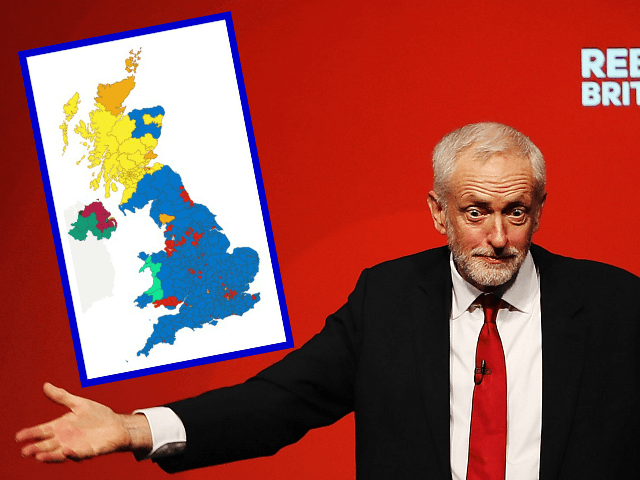Prime Minister Boris Johnson’s Conservatives have won their largest majority since Margaret Thatcher was returned to power for the third time in 1987, with an 80-seat majority.
With 162 seats more in the House of Commons than their next closest rival, Labour, the Conservatives’ pro-Brexit stance has redrawn the political map. Labour lost 60 seats — gaining only one, in London.
RESULT: National result for #BBCElection #GE2019.
Full results: https://t.co/tFoMAGcFsq pic.twitter.com/1GB8h8GMVD— BBC Election (@bbcelection) December 13, 2019
As revealed by the BBC below, it’s the subtle changes in the shift in Labour Red to Conservative Blue that reveal how Boris Johnson managed to break apart the Red Wall in the North of England.
As Conservatives win biggest majority since 1980s – take a look at our election results map of Britain and find out what's changed between 2017 to 2019 https://t.co/OxyAW2ZDc4 #GE2019 #BBCelection pic.twitter.com/u9WofbJP8E
— BBC Politics (@BBCPolitics) December 13, 2019
Some five million working-class Labour Leavers found themselves politically homeless after far-left Labour leader Jeremy Corbyn announced he would back a second referendum in July 2019. As a result, the Tories were able to break through 24 Red Wall constituencies with blocks of Boris Blue.
BBC analysis shows that the Conservatives were clear winners in seats that voted to leave the EU in 2016, taking almost three-quarters of those constituencies.
7/ So, how did this happen? As was seen in 2017, the Conservatives made their largest gains in areas that had voted to Leave in the EU Referendum https://t.co/o64M5GlCTD pic.twitter.com/WdOPnyt6ld
— Sky News (@SkyNews) December 13, 2019
Labour also lost seats in the north-east, and farther north in Workington — the home of ‘Workington Man‘, the average voter aggregate that the Tories targetted during the election: the older, white, Northern citizen who typically supports Labour but voted Brexit.
Amazing map from @thetimes interactives team showing the scale of the swing to the Tories across the country
More at https://t.co/GF2MDBj0L3 pic.twitter.com/IH2f4k2dxq— Matt Chorley (@MattChorley) December 13, 2019
While the Conservative gains may seem harder to see in what is already a wash of blue, the one Labour win — Putney in London, obtained from the Conservatives — has been clearly and simply presented thus:
A map of all Labour gains last night. pic.twitter.com/bjj4yUZ8TB
— Wings Over Scotland (@WingsScotland) December 13, 2019
Britain was not always so blue. When Labour under neoliberal Tony Blair was elected in 1997, the country was more dotted by red, including in the party’s former stronghold of Scotland, which has since become dominated by the left-separatist Scottish National Party (SNP, in yellow).
Election map 1997, vs Election map today. pic.twitter.com/x1V6rFjQ9U
— dan barker (@danbarker) December 13, 2019
While red has been consistently associated with the Republican party and blue with the Democrats since the 2000 election in the United States, it has historically been the reverse in the United Kingdom — with Labour’s red rose symbol being a nod to socialist red, in particular.
However, the effect is rendered much the same between Britain’s 2019 general election and the electoral college map from the 2016 presidential election. Both highlight that the left-wing tends to dominate in the liberal extremes of the west and east coasts, with ‘flyover country’ voting for Donald Trump, while in the United Kingdom it is London and other metropolitan and multicultural areas which remain Labour-controlled, while ‘Middle Britain’ backed Boris.
Here's the final 2016 Electoral College map https://t.co/hhE2IANqr6 pic.twitter.com/O51tI5jrTm
— Business Insider (@businessinsider) November 28, 2016
Follow Breitbart London on Facebook: Breitbart London

COMMENTS
Please let us know if you're having issues with commenting.